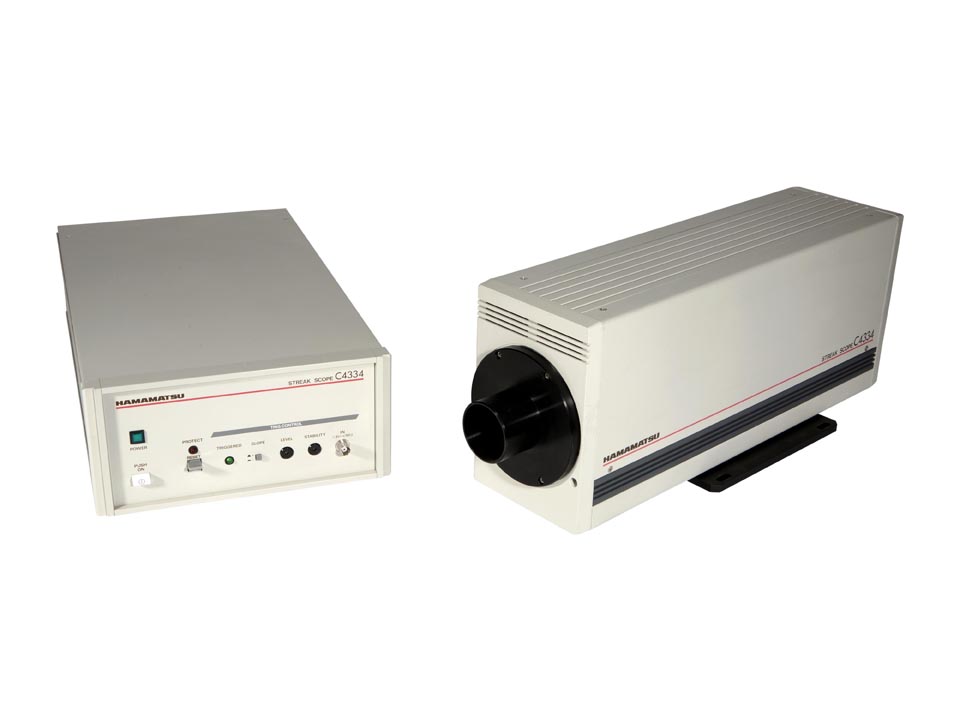C4334 Streak Camera

We no longer offer this product. If you want repair service or a custom modern equivalent, contact us.
This is a freshly refurbished Hamamatsu C4334-02S streak camera system. The Hamamatsu C4334 is an ultra-fast, high-sensitivity light photometric instrument which allows time-resolved photon counting to be carried out at multiple wavelengths simultaneously. The phosphor screen of the streak tube and fiber-coupled CCD enable two-dimensional single photon counting with higher efficiency, while repeated measurement at a maximum of 2 MHz results in high-speed integration of faint light and enables measurement with a good S/N. In addition, a wide dynamic range of 105 or more means that multicomponent lifetime fluorescence can be measured. For heightened convenience, all of the functions of the C4334 can be controlled through a host computer via USB with the included USB/GP-IB controller.
The C4334 can capture very dim phenomena, from picoseconds to milliseconds, by integration at sweep repetition rates up to 2 MHz. The spatial axis of the C4334 allows simultaneous capture of the spectral range, making the C4334 streakscope the ideal detector for time-resolved spectroscopy.
Includes
- Hamamatsu C4334-02S Streak Scope Controller with Cables
- Hamamatsu C4334-02S Streak Scope Head
- USB video capture device with software
- USB GPIB controller with software
- User manual
Accessories Available from Hofstra Group
- Spectrometer input for time-resolved spectroscopy
- Custom input optics
Streak Tube Condition
The streak tube in this system exhibits some burn-in that can be post-processed out in many applications, but will reduce dynamic range at low gain.
Click Here to Download Image Uniformity Report
Features
- High S/N Ratio
- Wide dynamic range
- Integrated CCD camera; no need for external readout system
Click Here to Download C4334-02 Spectral Response Graph
Click Here to Download More Detailed Specs
Click Here to Download Dimensional Drawings
Operating Principle
Streak cameras are high-speed light detectors which enable direct measurement of light phenomena with unsurpassed temporal resolution. They can simultaneously measure time, position (or wavelength) and light intensity, and process the data in real-time using a dedicated read-out system.
The streak camera converts incident light into electrons and performs a high-speed sweep (deflecting electrons from top to bottom), enabling detection of the time variation of the incident light intensity by converting these into different positions on the screen. (See figure below.)

The light pulse to be measured is focused onto the photocathode of the streak tube through the slit, where the photons are converted into a number of electrons proportional to the intensity of the incident light. These electrons are accelerated and conducted towards the phosphor screen, and a high-speed voltage which is synchronized to the incident light is applied. The electrons are swept at high speed from top to bottom and are then multiplied in the MCP (micro-channel plate), after which they are bombarded against the phosphor screen of the streak tube and converted to an optical image.
The optical image which appears on the phosphor screen is called a streak image, and shows the intensity distribution of the incident light, by which the positions of the electrons can be determined in the perpendicular direction over the passage of time. Using this method, the temporal intensity distribution of the light being measured can be displayed as the spatial intensity distribution on the phosphor screen.
Click Here to Download Guide to Streak Cameras
Specifications
Spectral Response |
400 to 900 nm |
|---|---|
Power Consumption |
180 VA |
Power Supply |
100/117/220/240 VAC, 50/60 Hz |
Sync Signal Input |
0.3 Vp−p / 75 Ω |
Reset Signal Input |
Reset at 0 V |
Streak Trigger Signal Input |
±Vp−p / 50 Ω |
Extinction Ratio |
5 × 103 or better |
Maximum Repetition Rate |
2 MHz |
Maximum Trigger Frequency |
150 MHz |
Communication Protocols |
USB 2.0 using included controllers and software |
Temporal Resolution |
< 15 picoseconds (single shot) |
Sweep Time/Full Screen |
1 ns to 10 ms |
Trigger Jitter |
<20 picoseconds (fastest range) |
CONTACT
JOIN US
ABOUT US
